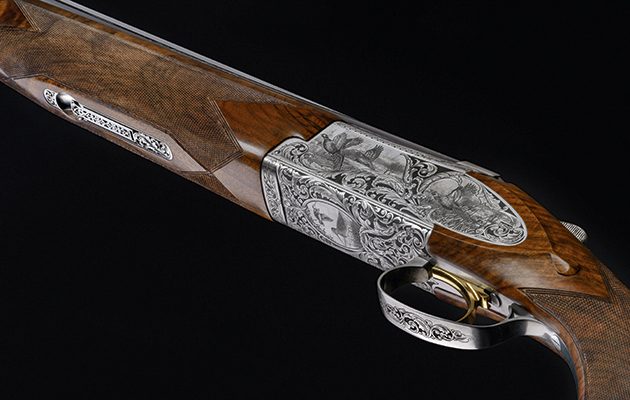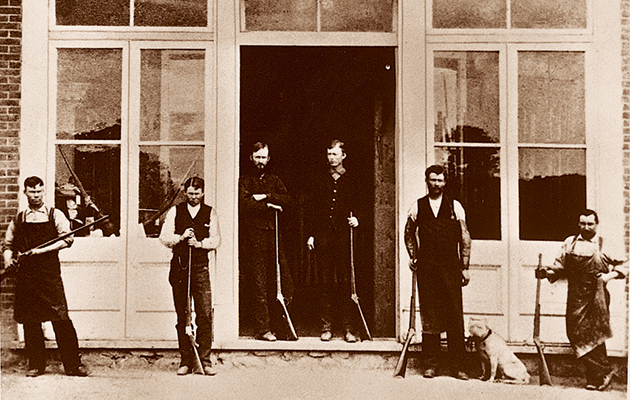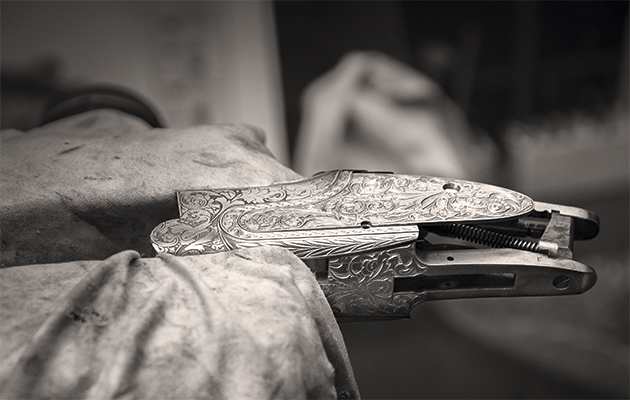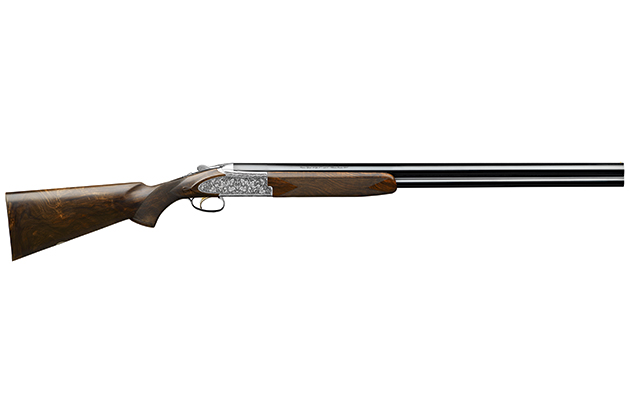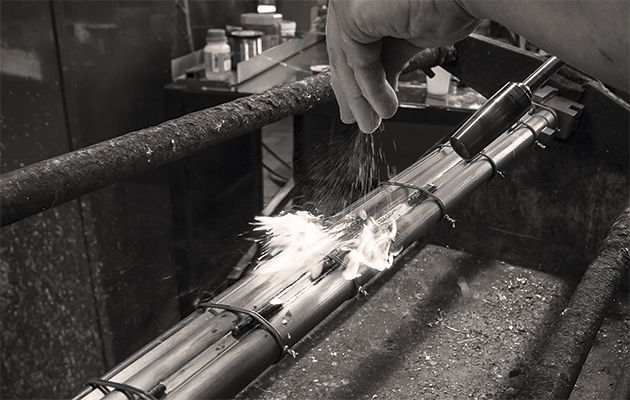Jonathan Young unravels the history of this iconic gunmaker as it launches its latest shotgun, the B15 Beauchamp, in the UK
With Browning launching their latest shotgun, the B15 Beauchamp, in the UK, Jonathan Young investigates the history of this iconic gunmaker.
For The Field’s review of Browning’s new over-and-under, read Browning B15.
BROWNING
Every Browning shotgun tells a tale of industrial history. It was designed by an American gunmaking genius but is now manufactured in Belgium – except when it’s made in Japan. This used to confuse me but a recent visit to the factory in Liège untangled the threads of time woven into this iconic marque.
Like many gunmaking centres, Liège is founded on ore, fuel and war. It lies in the Wallonia region of Belgium, which has extensive iron ore and coal deposits; during the medieval wars, citizens found a ready market for arms. In 1346, the year of the Battle of Crécy, the combined forces of Liège, Huy and Tongres attacked Hamal Castle with cannons of their manufacture. Continual warfare and the willingness of Liège’s arms manufacturers to supply the combatants led to Charles the Bold including a clause in the 1467 Treaty of St Laurence prohibiting “forging in the said City and country of heavy and light artillery, of suits of armour, as well as the melting down of metal, iron, brass or bronze for the manufacturing of military equipment”. But the profits of warfare will always attract and the city continued to provide arms for those who could pay, including the rebels in the American War of Independence. Not all of Liège’s output was for military use, however. Inevitably, a concentration of skilled craftsmen created market diversification and in the 19th century some, such as J Devillers and J Boussart, began creating luxury sporting shotguns for clients such as the Prince of Orange.
The industrial side continued to dominate and in 1889 arms manufacture was consolidated into the Fabrique Nationale d’Armes de Guerre, a company with the capacity for mass manufacture, such as the 150,000 Mauser 7.62mm rifles made for the Belgian government between 1892-94. FN, as it became known, branched into other products, such as bicycles and cars. It was this side of its operation that brought about the meeting with the Browning brothers, according to Ars Mechanica, the definitive work on FN, by Messrs Francotte, Gaier and Karlshausen: “On 2 April, 1897, the board sent its sales manager, Hart O Berg, to the United States to enquire about the advances which had been made in the manufacturing of bicycles. On the journey, Berg met two American arms manufacturers, brothers John Moses and Mathew Browning. John had just taken out a patent for a 7.65mm blowback operated automatic pistol. The manufacturing licence was offered to FN.”
From that chance meeting came a partnership that resulted in the Belgian manufacture of the Browning automatic shotgun in 1902 and his famed over-and-under, pretty much perfected in 1925 and known today as the B25 in commemoration of that date.
BROWNING: TODAY
Today, it’s still the flagship of the Browning range made in Liège, once known as The Custom Shop, a name slightly redolent of classic-car restoration and now rebranded “The John M Browning Collection”. In charge of production is Lionel Neuville, a 35-year-old trained gunmaker.
“My parents wanted me to be a doctor but I’ve always wanted to be a gunmaker, so I joined the Belgian Gunmaking School instead,” he explained. “It’s a pretty difficult course and no one is allowed to progress until they’ve shown they can produce a perfect cube of steel, within a micron’s accuracy, using nothing but a file, their hands and eyes. I also did a year at the Austrian Gunmaking School in Ferlach and my experience allowed me to get a job at EJ Churchill’s for two years, after which I did a business and sales degree, then joined Herstal Browning, where I’ve been for the past nine years. Despite being owned by the Walloon Region of Belgium, it’s run very much as a private company with a family atmosphere, and both Philippe Classens, the head manager of the Herstal Group, and Damien Kaivers, the CEO of Browning, are frequently on the shop floor. At present, there are 15 gunmakers in the workshop but we need 20. Every one of them loves their craft and every gun from the John M Browning Collection is dispatched with a ‘passport’ signed by all the individuals who made it.”
Up until last year, production was centred round the B25, a “hand-made gun fashioned from blood and sweat”, according to Neuville. The company makes some 40 to 50 of them a year and they retail at £13,000 to £50,000 each. “We think that’s good value for such an exceptional gun. The barrel tubes are made in house from Crm04 steel and the barrels can be supplied either in monobloc form, for use with steel shot, or chopperlump for lead. What’s really exceptional about the B25s is their closing system. With the famous ‘trap-door’ and underpin on the bottom of the action, there’s no lateral or vertical movement: all the recoil, and therefore wear on the gun, is transmitted along a horizontal plane so they don’t shoot loose,” added Neuville, as he introduced me to the craftsmen working on the benches.
There were the files, each made for the task by the individual worker; the smoking lamp gently deployed to ensure perfect fit of barrels to action; and the musical chinking of the engraver’s hammer as she artfully fashioned a partridge’s feather on a sideplate. Little different, in fact, to the scene familiar to anyone who’s visited a London gunmaker building guns for a considerably heftier price. “Ah, but they are making sidelocks and that’s a more complicated process,” said Neuville tactfully.
BROWNING: THE NEW B15 BEAUCHAMP
He steered me over to a rack of guns that appeared similar: the new B15 Beauchamp, finalised in 2015 though being launched in the UK in 2016. Why “Beauchamp”? “Well, we liked the look of the word,” said Neuville, “and the fact that our potential clients know it’s pronounced ‘Beecham’.”
Unlike the B25s, the new B15s are part Japanese, a heritage traced back to 1893 and Karaji Miroku, a small gunmaker living in Shikoku, the smallest of the four main Japanese islands. The company flourished making, among other things, harpoon guns for the whaling fleet and in the late 1950s Miroku started making high-quality over-and-unders based on the B25 design. The standard of Miroku engineering was so high that by the late 1960s the two companies started working together and in 1973 they began producing an over-and-under based more closely on the original Superposed design created by John M Browning.
Since then, Miroku has forged a name for utter reliability among many of Britain’s top gameshots, people who need a gun capable of firing thousands of cartridges a year without a falter. As a result, in 2016 the company will make some 5,000 guns, some sold under the Miroku name, others under Browning colours, such as the new Browning 725. The B15 blends both that manufacturing excellence with a degree of elegance traditional to the Liège hand-made guns.
“We set out to build the perfect shooting machine that’s hand finished,” said Neuville, “and we think we’ve succeeded. It’s made by Miroku, based on the B725 model, and the parts are pre-assembled in Japan to be as perfect as possible. But 70% of the work – the jointing, chequering, finishing and engraving – is carried out here in Liège. They’re all steel-shot proofed with a low-action profile and fitted with mobile chokes. We had the UK market very much in mind when we developed it, and of the 100 we’ll make this year 80 will be sold in Britain. Price depends on grade, determined by the quality of the engraving and walnut, with B grade at £9,800 and finishing with the E grade at £15,300. They come in 28-, 30- and 32in-barrel options and pairs and 20-bores will be available in 2017. What won’t be on offer is custom-fitted stocks, as we want to keep the price competitive. Having said that, the wood itself is impressive over all four grades,” added Neuville. “I buy the blanks myself, and while some customers like those from Kazakhstan and Uzbekistan, the walnut can be grey so for the British market, which prefers a darker, redder wood, we buy from Turkey; my supplier lives some 50 miles from the Syrian border. We don’t cut corners with the engraving, either. Our craftsmen spend 50 hours engraving the B15 grades D and E and it’s our view that, at this price, the B15 has the highest degree of hand finish of any comparable shotgun currently on the market.”
Neuville believes the combination of traditional Browning finish and Miroku reliability will appeal to the British sportsman, a view shared by the 2012 Olympic shooting coach and retailer, Ian Coley: “We have just taken delivery and a lot of thought has gone into creating the B15 model. It has both wonderful wood and engraving and handles and balances superbly – just like the B25 but at a more affordable price. Without doubt, it offers superb value for money and, depending on the supply situation, I could well be using one myself next season.”
THE KEY “JOHN M BROWNING COLLECTION” CRAFTSMEN
Jean-Pierre Bailly
62, engraver
He works with Gwenda Lieben, the only woman in the workshop. Bailly joined FN Herstal in 1980 after his studies at Léon Mignon engraving school (Liège).
Gwenda Lieben
36, engraver
Like Bailly, she works both on the B25 and the B15. She has also studied at Léon Mignon.
Bernard Cajot
57, actioner and finisher
Joined FN Herstal in 1978.
Vincent Hody
37, stocker
Studied in Verviers, a city close to Liège.
Nicolas Yans
28 , bluing and chequering
Joined Browning in 2007 after his studies at Léon Mignon. In charge of barrel bluing and stock chequering.
Jean-François Panza
37, barreller
Joined Browning in 1999 after his studies at Léon Mignon.





